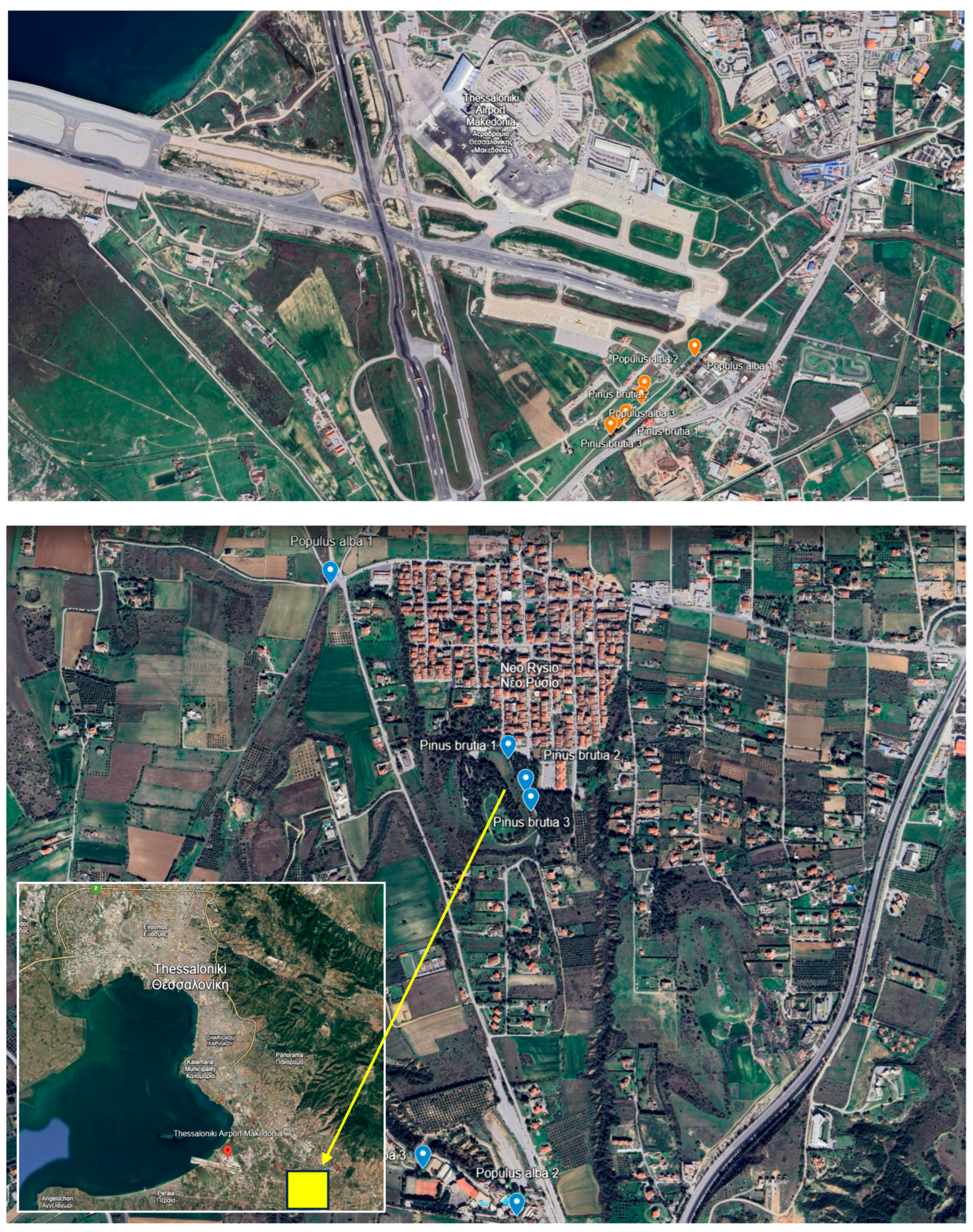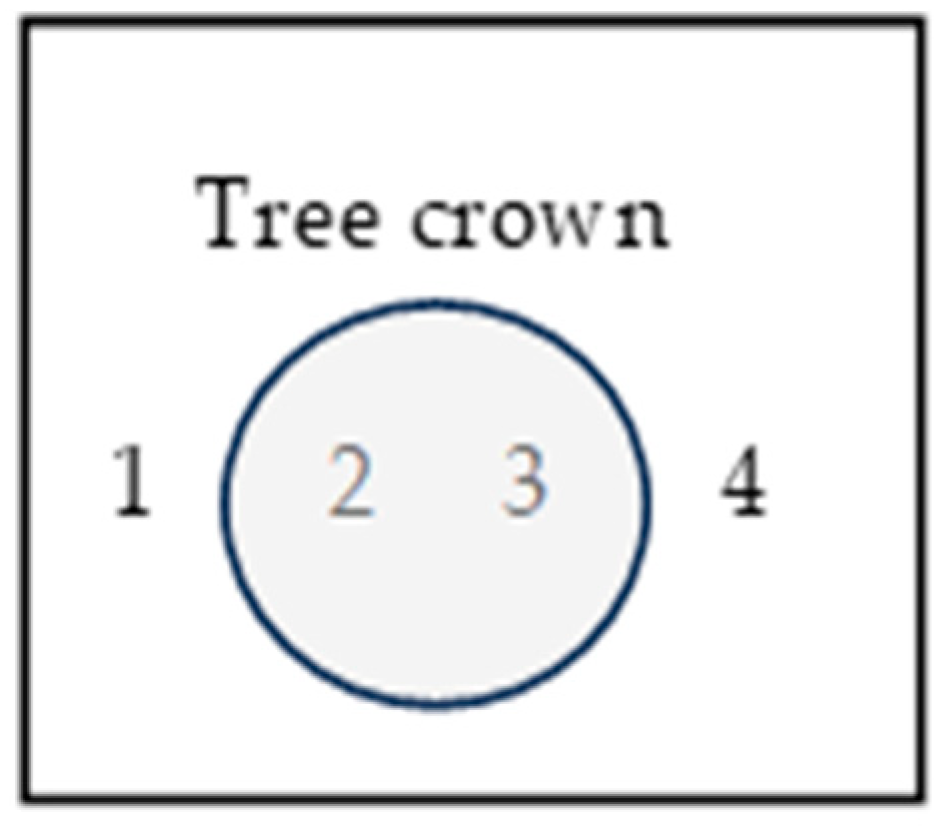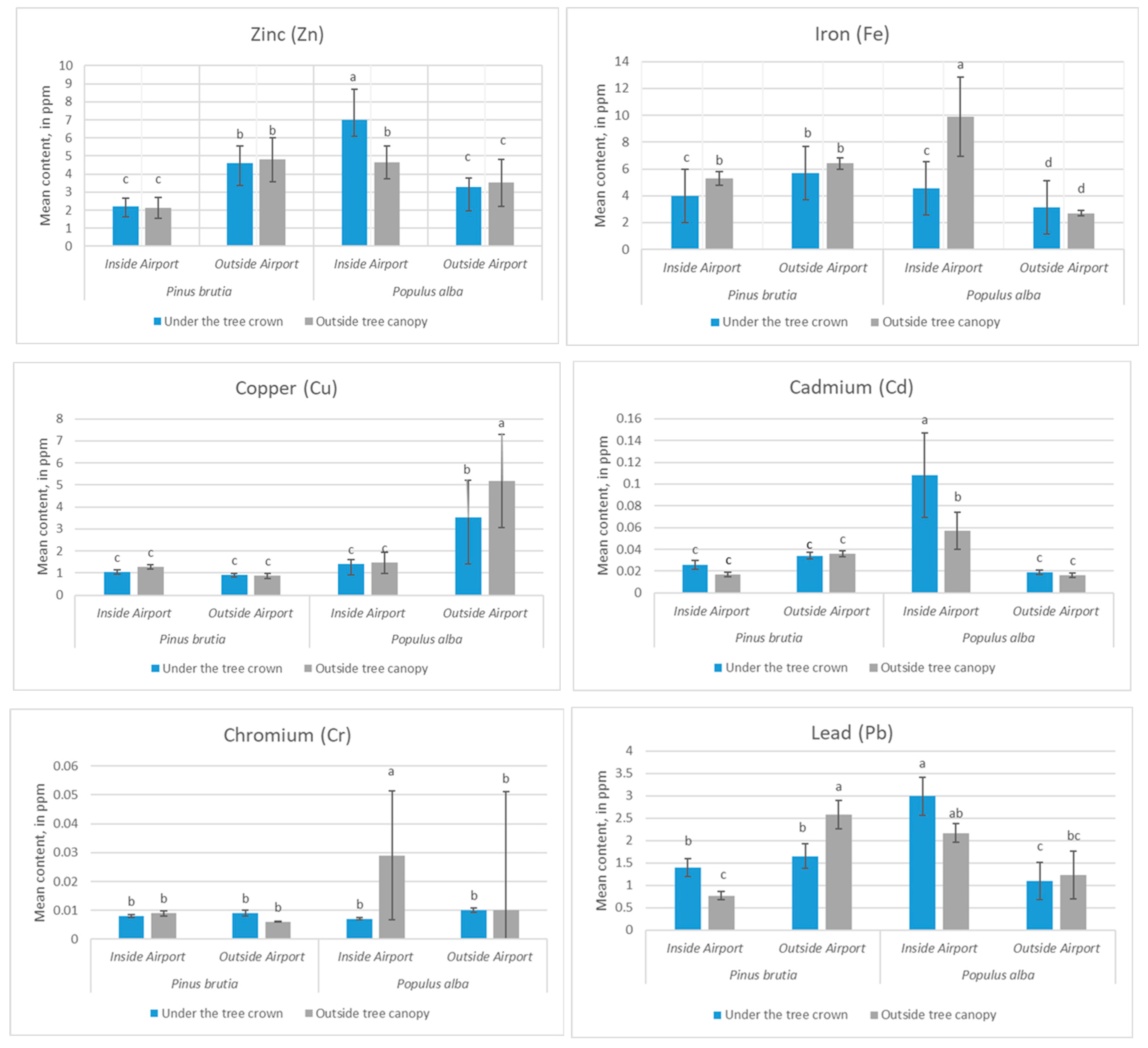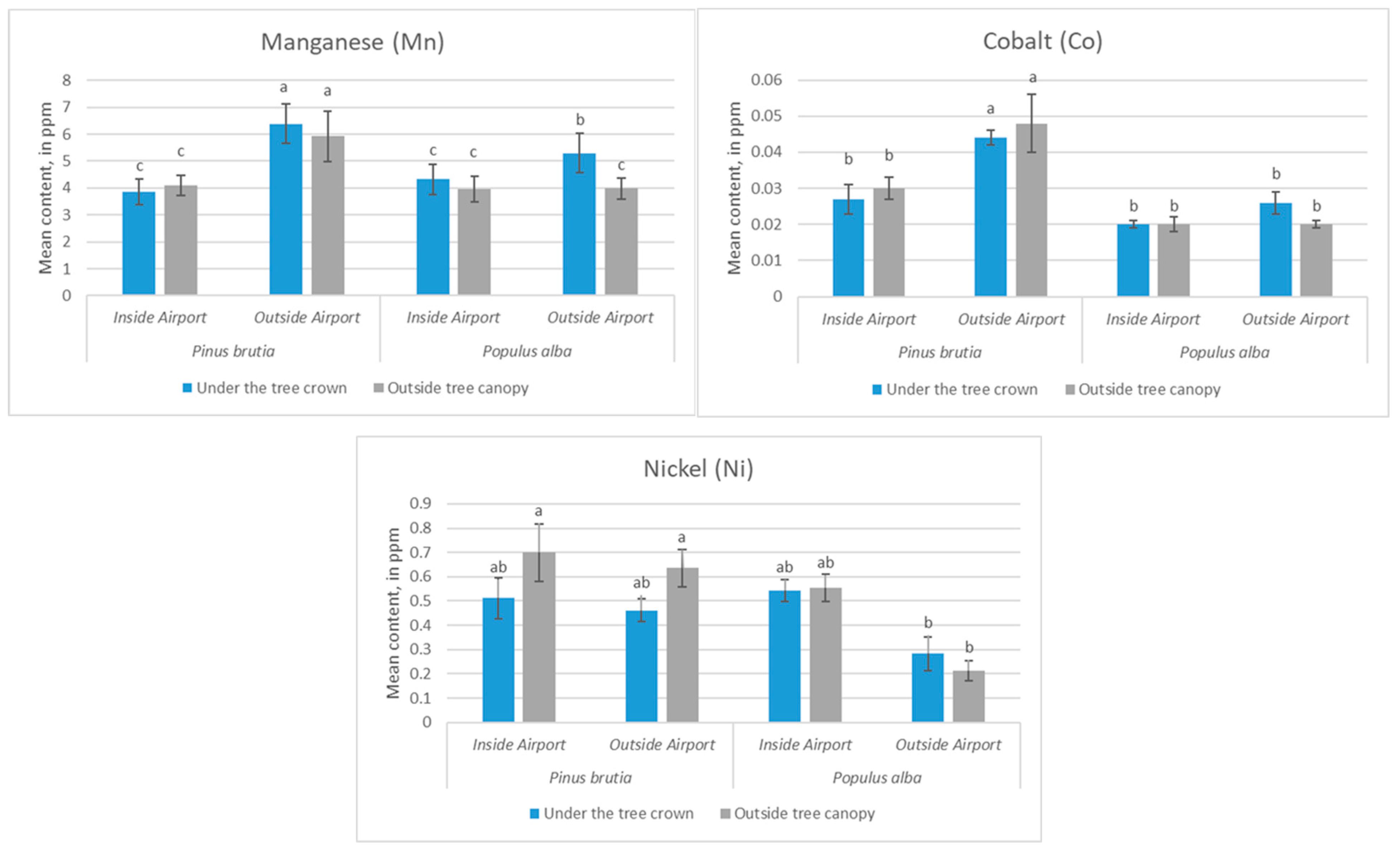1. Introduction
Air transportation is a major source of environmental pollution; more than 99.9% of flights are powered by the burning of fossil fuels, adding over a billion tons of CO
2 to the atmosphere each year [
1]. Air and soil pollution in airports is caused by aircraft operations and ground activities as well as access to road transport, and its impacts could be hazardous to organisms and humans [
2,
3]. A wide variety and quantity of sources of emissions are noted at airports due to aircraft operational emissions, sources of infrastructure or fixed assets, and sources of road traffic [
4]. Some specific activities affecting soil conditions are the application of de-icing and anti-icing substances to aircraft during winter operations. In addition, to ensure the safety of aircraft operations and the durability of runways, runoff from the pavement is drained as soon as possible and collected in an adequate drainage system [
5]. Surface spills of fuel, which usually occur at aircraft stands and usually result from overfilling of aircraft and vehicles, are a significant source of contamination. Although large spills are usually cleaned up, smaller ones may be carried into the stormwater drainage system, some of which may be permeable, thereby allowing contaminated water to seep into the ground [
6,
7]. The repair of composite parts generates waste containing Kevlar, glass fibers, and organic solvents, including toluene and acetone. Electrical circuit repair produces waste with cleaning fluids to remove glue, wax, oil and grease from electronic components, metals, and other materials. Engine maintenance and wheel, tire, and brake repair produce waste with vitreous and non-vitreous solvents, fuel, hydraulic, brake and lubricating oils, greases and specialty oils (e.g., dielectric heat transfer) [
8]. Activities for fire training with different types of fuel (kerosene, butane, propane, wood) may contribute to soil pollution. There are also important sources of emissions from non-air traffic mainly due to vehicular traffic, motorcycles, cars, semi-trucks, trucks, buses, and coaches connected to the airport on access roads, pavement, and parking areas on or off the premises (including engine shutdown, starting and fuel tank exhaust emissions). Thus, because of the airport operation, soil pollution is expected mainly in the airport area; however, it probably occurs in the surrounding area as well, including pollution due to high concentrations of (toxic) metals.
Toxic metal pollution of the soil refers to the excessive deposition of toxic metals in the soil mainly caused by human activities. The most common chemicals involved are petroleum hydrocarbons, solvents, pesticides, lead, and other toxic metals of biological toxicity, such as mercury (Hg), cadmium (Cd), lead (Pb), chromium (Cr), and arsenic (As). These also include some other metals of certain biological toxicity, such as zinc (Zn), copper (Cu), nickel (Ni), tin (Sn), vanadium (V), etc. In recent years, with the development of the global economy, both the type and content of toxic metals in soil caused by human activities have gradually increased, resulting in environmental degradation [
9,
10,
11,
12]. Toxic metals are particularly dangerous for the environment and organisms. Once the soil is affected by contamination, it is difficult to restore it. When it exceeds the environmental tolerance or when environmental conditions have changed, toxic metals in soil can be activated and cause serious ecological damage [
13,
14]. They exhibit toxic effects toward soil biotic beings, affecting basic microbial processes and reducing the number and activity of soil microorganisms [
15]. Chen et al. [
16] reported that toxic metals cause a decrease in bacterial species diversity, a relative increase in soil actinomycetes, or even a decrease in the biomass and diversity of bacterial communities in contaminated soils. Karaca et al. [
17] reported that enzyme activities are affected differently by various metals due to the different chemical relationships of enzymes in the soil system. Ashraf and Ali [
18] also reported that toxic metals exert toxic effects on soil microorganisms, resulting in changes in the diversity, population size, and overall activity of soil microbial communities. It was also observed that metal (Cr, Zn, and Cd) pollution affected the metabolism of soil microorganisms in all cases. Cd is more toxic to enzymes than Pb because of its greater mobility and lower affinity for soil colloids. Cr (VI) is a strong oxidizing agent and is highly toxic, while Cr (III) is quite less hazardous [
19]. Cr (VI) toxicity in plants includes delayed seed germination, damaged roots, reduced root growth, reduced biomass, reduced plant height, photosynthetic impairment, membrane damage, leaf chlorosis, necrosis, low grain production, and ultimate death of the plant [
13,
20]. In general, an increase in metal concentration negatively affects the properties of soil microorganisms [
21].
The high concentration of toxic metals in soil also has many negative effects on plants grown in polluted soils. Most plant species cannot adapt when the physical, chemical, and biological properties of the soil change due to soil pollution. Soil fungi and bacteria begin to decline, creating an additional problem of soil degradation. Soil fertility slowly declines, making the soil unsuitable for agriculture and for the survival of any vegetation. Soil contamination makes large tracts of land hazardous to health [
22]. Low concentrations of toxic metals in soil does not affect plant growth. However, if the concentration is too high, toxic metals can be absorbed by the plant, causing them to become poisoned and even die. One of the most important factors for metal toxicity is the pH of the soil; an alkaline pH of the soil could restrict the mobilization of the metals in soil matrix, controlling the metal uptake by crop plants, thereby reducing the risk of metal toxicity [
23]. The limit values of toxic metals in the soil for good production are listed in
Table 1 [
24]. Similar target values were specified by the WHO (World Health Organization) for the soils to be characterized as unpolluted soils [
13] (
Table 1). While in
Table 2, the limit values of toxic metals in some European countries are presented [
25].
On the other hand, tree functions affect soil chemical properties as well as the content of soil metals [
26]. Tree presence influences soil content of toxic metals. However, this influence is not similar for all elements, and it greatly depends on the morphological and functional characteristics of the tree species [
27]. Generally, each element follows a different pattern that depends on the functions of the tree species. For example, Tőzsér et al. [
28] reported that different
Populus species present different effects on soil metals, while Alahabadi et al. [
29] reported that (toxic) metal accumulation patterns vary among different tree species and plant tissues.
The environmental impacts of air transport have become increasingly important [
30], and the role of trees in pollution mitigation by capturing them has been greatly recognized [
31]. At the same time, there is a great scarcity of real pollution data on the impact of airport operations on ecosystems as well as the role the trees could play in pollutant limitation. Thus, the aims of this study were as follows: (i) to determine whether airport operations have toxic effects on airport soils, (ii) to determine if there is an impact of airport operations on the soils of the surrounding area, and (iii) to determine the effect, if any, of different tree species on the degree of soil pollution by the potentially toxic elements, in the area within the airport of Thessaloniki, Greece, and outside the airport near the runway. The overall goal was to assess whether airport traffic had actual toxic effects in the territory of the airport area, but also in the surrounding area. The hypothesis is that trees with different morphological and functional characteristics can modify the degree of soil pollution through their crown. The forest species
Pinus brutia and
Populus alba were selected both inside and outside the airport, and the concentrations of toxic metals (Cr, Cu, Co, Zn, Ni, Pb, Fe, Mn, Cd) in soils and how they is affected by tree canopy of the different forest species were examined.
4. Discussion
The current research was carried out with the aim of investigating the soil conditions and the concentrations of toxic metals in the area of Thessaloniki Airport, Northern Greece, and in the surrounding area. Generally, the results of the soils studied showed that no concentration was found to exceed the defined permissible limits according to international standards (
Table 1 and
Table 2) [
13,
24,
25], with the exception of iron. The soil pH was slightly alkaline (average values of approximately 7.5, with no differences between sampling sites inside and outside the airport). This constancy of the soil pH suggests a similar bioavailability of the studied toxic metals and metal ion activity in solution of the soils of the airport area. Soil total nitrogen and organic matter were quite high, both inside and outside the airport (mean values for organic nitrogen and organic matter of over 0.3% and 4.5%, respectively) and greatly varied between the sampling sites.
Concerning the analysis of toxic metals concentrations in the soil, first, we must point out that some differences were revealed in the content of the toxic metals studied between the samples taken inside and outside the airport. These differences concerned the following elements (toxic metals), namely iron (Fe), copper (Cu), cadmium (Cd), chromium (Cr), and nickel (Ni). Based on the data analysis, statistical differences in the soil content were found for these five toxic metals. For all these elements, except for copper, the soil content was found statistically higher in the soils inside the airport, which means that the operation of the airport burdens the soil with higher concentrations of these four toxic metals. It is worth pointing out that Thessaloniki Airport has been in operation for over fifty years. Thus, the higher levels of these elements is due to the accumulated impacts of operation, and these findings indicate the current environmental conditions of the area. Only in the case of copper was the opposite result observed (the values were higher outside the airport). On the contrary, no effect was observed for the following soil toxic metals, manganese (Mn), zinc (Zn), cobalt (Co), and lead (Pb). This means that there is an overall low encumbrance of airport operation within the airport area for some toxic metals, but not for others.
This encumbrance differs depending on the presence of tree species as well as on elements studied. For the following five elements, namely, zinc, iron, cadmium, nickel, and lead, the highest average concentrations (7.021 ppm, 9.883 ppm, 0.108 ppm, 0.699 ppm, and 2.99 ppm, respectively) were found in soil samples related to
Populus alba inside the airport. For copper and chromium, the highest average concentrations (5.17 ppm and 0.029 ppm, respectively) were found in soil samples related to the
Populus alba species outside the airport and near the runway. While, for manganese and cobalt, the highest average concentrations (6.385 ppm and 0.048 ppm, respectively) were found in the samples referring to the trees of
Pinus brutia, also outside the airport. The analysis of source contribution to metal differences presented in
Table 10 indicates that, among the factors studied, the tree position (sampling site) has the higher contribution to metal differentiation. From the comparison of the above values, with the values in
Table 1 and
Table 2, we conclude that no value of any elements exceeds the permissible limits except for that of iron (Fe). In fact, all other concentration values, even the maximum ones (
Table 9), are quite low and do not cause concern for soils both inside and outside the airport.
In comparison with the worldwide literature data, the results obtained in this study from the Macedonia Airport, Northern Greece, are similar to those of the other airports where similar studies were conducted. More specifically, similar investigations have been carried out at Athens International Airport, Delhi International Airport, Warsaw Airport, and Hatay Airport. By comparing the results of the existing literature and the toxicity limits in the soils, we can give a first estimate of the concentrations of toxic metals. Massas et al. [
42] assessed the quality of the environment after 13 years of operation of the airport and measured the concentrations of toxic metals, including lead (Pb), copper (Cu), zinc (Zn), nickel (Ni), chromium (Cr), manganese (Mn), and iron (Fe), in its peripheral soils. They concluded that the average concentrations were at low levels in general but observed an accumulation of metals in the northern and eastern parts of the airport. Despite the small number of samples, they concluded that the daily flight load likely burdens the areas with greater accumulation and that periodic research is required for the above elements.
In another case, Ray et al. [
43] conducted a similar soil sampling of the airport perimeter and measured the concentration of eight metals, including lead (Pb), copper (Cu), zinc (Zn), nickel (Ni), chromium (Cr), manganese (Mn), and iron (Fe). From the results of the research, it was initially found that the concentrations of toxic metals, excluding iron and manganese, were higher inside the airport by one and a half times compared to the remote surface. At the same time, regarding the points inside the airport, a greater concentration was found in the landing part of the aircraft, compared to that of take-off and taxiing. At Warsaw Chopin Airport, Brtnický et al. [
44] examined soil pollution with the help of indicators and showed low soil pollution in the vicinity of the airport runway. The airport soil was found to be slightly polluted, but due to the constant growth of the airport traffic, an increase in contamination can be expected in the future. In addition, regarding Hatay Airport, Turkey, Ozkan et al. [
45] concluded that the agricultural land around the airport had not been contaminated by toxic metals except for iron, which could come from soil fertilizers.
Tree presence was found to influence the soil content of toxic metals, but this influence is not similar for the studied elements or the same for the studied tree species. Each element follows a different pattern that depends also on the presence of tree species. Similar conclusions were made by Tőzsér et al. [
28] for
Populus species as well as for different tree species. Alahabadi et al. [
29] reported different patterns for metal accumulation in tree plant tissues. According to worldwide data, it is well documented that morphological and functional characteristics of the tree species affect their influence on soil metals [
26,
27]. This trend was confirmed in this study in the area of Thessaloniki Airport, Northern Greece. More specifically, it is reported that the concentration of metals in soil depends, among other factors, on the presence of plant species, especially trees, and their morphological and functional traits [
46]. The results of our study confirm the aspect that different tree species result in the cycling of different elements (
Figure 4 and
Figure 5), which are attributed to their different morphological and functional traits, such as leaf area index, leaf form or needles, leaf decomposition rate, element cycling, tree growth rate, crown surface area, crown form, and biological processes [
47,
48]. However, although it is generally suggested that evergreen species have higher capacity and retain a larger number of metals in their foliage than deciduous trees, other studies report that broadleaves play an important role in removing air pollution [
46,
48,
49], and among broadleaves trees, those with rough leaf surfaces are more efficient [
50].
To sum up, based on the analysis of the field data collected in this study, no important pollution was detected in the soil of the Thessaloniki Airport, Northern Greece, both inside and outside the airport area, despite the observed significant differences for some toxic metals in soils sampled inside and outside the airport. It is important, however, to perform the temporary re-checking of the values with new samplings in order to prevent and optimally manage the natural wealth of the region. It is a given that the region will experience greater prosperity, and air transport is expected to increase rapidly in the near future [
51,
52], and these factors cumulatively may affect air pollution and the accumulation of toxic metals in the soil and vegetation [
44]. We have to point out that any differences found in toxic metal concentrations inside the airport and outside the tree canopies are probably not related to tree species but to the position of sampling in regard to any pollution sources.
The results provide information on potentially toxic concentrations that affect the soils of the area and, by extension, the vegetation and the water table. The results obtained allow us to assess the current conditions and form the basis for the optimal management and protection of soils from pollution originating from human activities. Land pollution from air transport is a topic that has not been studied in depth; thus, further research is needed, especially under the expected significant increase in air transportation across planet earth [
53].












